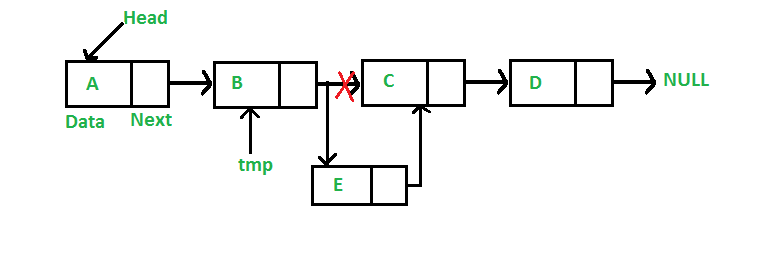Single Linked List

Navigation system works on the concept of linked list.
1. Introduction:
Single linked list is a linear data structure. It is slightly different from array. It made by the nodes, each nodes consist a data and the address of the next node and each node are linked using pointers. Here data are not stored in the contiguous memory location, nodes are present anywhere in the memory space but every nodes are linked with eachother that’s why we call this linked list. Main benefit of linked list is that we can insert or delete data from any position in the list.
2. Creation of Node
To create a new node in C++, you will need to define a structure or class that represents a node, and then create an instance of that structure or class. Here we will use structure to create or define a node.
Here is an example of a node structure in C++ or C:
|
|
3. Insertion
An insertion operation in a single linked list involves adding a new node to the list. For this first you have to create a newnode and then insert this node where you want. There are several ways to insert a node in the list:
- At the beginning of the list
- At the end of the list
- At a specific position of the list
3.1 Insertion at Begining
To insert a new node at the beginning of the list, you need to create a newnode and set it’s next pointer to point to the current head of the list. Then, you can set the head of the list to the newnode. You also have to check whether the first node is present or not in the list or we can say list is empty or not.
|
|
3.2 Insertion at Last
To insert a new node at the end of the list, you need to traverse the list until you reach the last node. Then, you can set the next pointer of the last node to point to the newnode. If the list is empty then set the head to the newnode.
tempis just a temporarynodejust likecountvariable, after the operation it does’nt have any importance.
|
|
node in a data structure, such as a linked list, tree, or graph. There are several way to traverse. Here we use the simple traversal technique in which we form a temp variable or node and traverse the each node one by one just pointing to the next pointer to the temp.
temp=temp->next;3.3 Insertion at Any Position
To insert a new node at a desired position in the list, first you need to make a temporary node say temp initialise with head then traverse the list until you reach the node before the position where you want to insert the newnode. Then, you can set the next pointer of the newnode to point to the node at the desired position, and set the next pointer of the node before the position to point to the newnode.

|
|
node at that position.4. Deletion
A deletion operation in a single linked list involves removing a node from the list and free the space. First make a temp node, traverse to that node and do the operation. There are several ways to delete a node from the list:
- Deleting the head node
- Deleting the last node
- Deleting a node from the specific position of the list
4.1 Deletion from Begining
To delete the head node or first node, first you have to make a temp node initialise with head then set the head of the list to the next node in the list. Now free the temp.
|
|
4.2 Deletion from End
To delete the last node, make a temp node traverse the list until you reach the second-to-last node. Set the temp to the last node of the list. Then, you can set the next pointer of the second-to-last node to null. Now free the temp.
|
|
4.3 Deletion from Any Position
To delete a node in the middle of the list, you need to traverse the list until you reach the node before the one you want to delete. Set the temp to the node to be deleted in the list. Then, you can set the next pointer of the previous node to point to the node after the one you want to delete. Free the temp.

|
|
node from that position.5. Sorting
There are several way to sort the list.
|
|
6. Reversing
To reverse the linked list, You have to iterate the linked list and for each node, changing the next pointer to point to the previous node instead of the next node as it traverses the linked list. This effectively reverses the order of the nodes in the linked list. The function returns the reversed linked list by returning the last node in the original linked list as the new head.
|
|
7. Print Function
To print the list you have to travarse the list and print each node one by one. For this make a temp node initialise with head, travarse and print.
|
|
8. To Find Length
To find the length of the list, first make a temp node initialise with head than travarse the list and increment the count by 1 on every travarsal until you reach to the last node. At last print the count value.
|
|
9. Main Function
In the main function. we check all the function whether they are working or not, call all the functions one by one.
|
|
It will be a better practice if you take the input from the user in the output terminal. In this case the main function will be:
|
|
Complete Code of Single Linked List: Code
<div style="position: relative; padding-bottom: 56.25%; height: 0; overflow: hidden;">
<iframe allow="accelerometer; autoplay; clipboard-write; encrypted-media; gyroscope; picture-in-picture; web-share" allowfullscreen="allowfullscreen" loading="eager" referrerpolicy="strict-origin-when-cross-origin" src="https://www.youtube-nocookie.com/embed/FMzj9UYHTPQ?autoplay=0&controls=1&end=0&loop=0&mute=0&start=0" style="position: absolute; top: 0; left: 0; width: 100%; height: 100%; border:0;" title="YouTube video"
></iframe>
</div>
 Sm0king B!ts
Sm0king B!ts